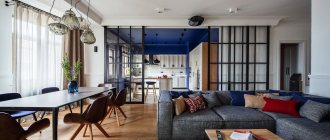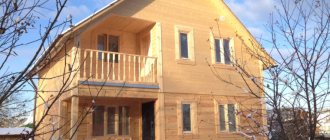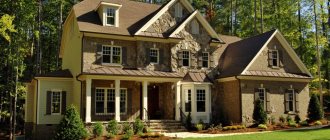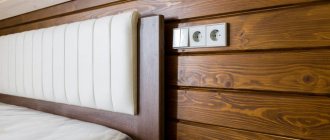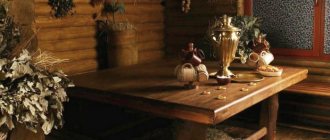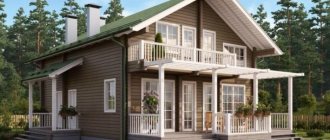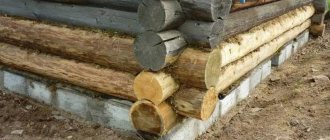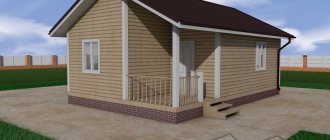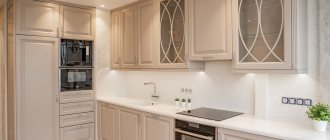Peculiarities
A house made of timber has a number of characteristics that are not typical for houses made of other materials. Among them there are both positive and negative qualities.
The advantages of wood include:
- The material is environmentally friendly.
- A house built from timber has a very presentable appearance.
- Constructing a building from wood elements takes less time than working with other materials.
- There is no need to spend a lot of time laying an expensive foundation, since the timber will not create large loads.
- Compared to other materials, wood has a lower price.
The following points are considered as nuances that cause difficulties:
- Over time, shrinkage of wooden buildings usually occurs. In its primary stage, it occurs during the first two years from the moment the house is built. Under the weight of the roof, the distance between adjacent beams decreases, resulting in the formation of cracks, as well as a decrease in the ceiling height by a couple of centimeters.
Also, the shrinkage process can be explained by changes in temperature and humidity, but in this case the interior finish most often remains unharmed.
- Wood is also a material that can develop infestations or rot over time. Therefore, you need to carefully process the beams and monitor the humidity level.
When the building is erected, all the internal work to be performed must be carefully planned.
The main procedures for interior arrangement and finishing include:
- Laying communication systems. These include heating, sewerage, electricity, and water supply systems.
- Coating walls with special compounds and antiseptics that protect against fire.
- If desired, you can carry out thermal insulation and waterproofing of the floor and walls.
- Next, the subfloor is laid.
To make the work more organized, it is recommended to prepare in advance a project for the arrangement and finishing of all rooms.
- Partitions and other additional structures are being installed.
- Walls, ceilings and floors must be carefully prepared before decorative finishing.
- After this, the finishing itself is carried out.
The interior decoration of a building made of timber as a whole is a rather labor-intensive process, so it is important to describe in detail all stages of the work, as well as to correctly select the material for finishing various surfaces.
Natural wood materials used for exterior cladding of a wooden house
When choosing the best way to sheathe the outside of a wooden house, natural wood materials inevitably come into view:
- lining;
- block house;
- imitation timber;
- Planken.
All of them have obvious advantages as a natural material, but they also have the same disadvantages as any wooden product. This leads to the fact that in addition to the cost of purchasing the material, it is necessary to incur certain costs for finishing with antiseptics and topcoat varnishes and paints.
Lining
The cheapest and most technologically advanced type of natural wood cladding is slats with profiled sides that form a groove/tongue connection. During installation, the lining is firmly and tightly connected and forms an almost monolithic surface.
For finishing, exclusively dry lining is used, with a humidity not exceeding 10 - 15%. If you use insufficiently dry lining, it will inevitably dry out and cracks will appear along the mating lines.
There are several standards for lining, the average dimensions of which are:
- thickness – 12 – 40 mm;
- width – 76 – 200 mm;
- spike length - 4 - 5 mm;
- length - 2 - 6 m.
The lining is installed in a horizontal position, starting from the bottom, with the tenon facing up. If you install it with the groove up, then the water flowing down the wall will get into the lock and over time destroy it and the lining itself. With proper installation and proper care, clapboard cladding will last 10 - 15 years, and if it is impregnated with modern antiseptics, even longer.
The advantage of such cladding is its low cost and ease of installation. Anyone who can hold a hammer and use a building level can handle the installation.
Imitation of timber
It is the same prefabricated surface as the lining, but slightly different in appearance. It can also be installed horizontally, only visible joints are practically invisible. After final installation it looks like a wall made of profiled timber. It is made from spruce, pine, cedar or larch; due to the resinous nature of these species, it is quite durable.
The material is produced in the form of boards 2–4 m long, 20–35 mm thick and 105–175 mm wide. You can buy a solid board, cut from one log, or spliced, glued together under pressure from narrower slats. In terms of performance, both types are approximately the same.
Pros and cons are similar to lining. Imitation timber wins only in appearance - the material is more modern and decorative.
Block house
An excellent finishing material, made in the form of boards with a semicircular outer side. When assembled, the material creates the appearance of a log structure. Very decorative, durable and no more difficult to install than lining. Compared to lining and imitation timber, a block house is more durable, holds heat better and is much more durable.
Coniferous wood species are used to make slats, in most cases pine and spruce. Impregnation with various stains, glazes and glazing materials allows you to give the finish the appearance of any valuable type of wood. When painting with oil or alkyd paints, most of the effect of using a block house disappears (in the case of imitation timber, this does not happen).
The block house also has good thermal properties. Compared to previous materials, it retains heat in the house better and lets the cold in worse. But the cost of covering with this material is higher.
Planken
This is a relatively new material in our latitudes. It is a façade board with beveled or rounded side edges. Made from pine, larch or wood-polymer materials. The width of the board is in the range of 70 – 140 mm with a thickness of 15 – 20 mm, the bevel angle of the edges is 45 – 70. It is mounted on special fastenings with a tenon or an overlap.
Very convenient for installing ventilated facades. As a rule, it is sold in a form treated with fire retardants and antiseptics, therefore it is resistant to biological pests and safe in the fire sense.
In most cases, high-quality planken is impregnated with environmentally friendly products, but when purchasing it is a good idea to check the certificate. Cheap materials can be treated with toxic reagents.
Front of work inside a timber house
Finishing the floor, walls and ceiling in a log house made of laminated or profiled timber is done by hand in several stages:
- laying communication lines (electrical cable, pipeline, heating system, sewerage, air conditioning);
- impregnation of wood with antiseptic agents to protect against fire, insects, mold and fungi;
- installation of heat and waterproofing material;
- preparing walls, floors and ceilings for finishing;
- installation of interior doors;
- finishing of floors, walls and ceilings.
Without certain skills and the necessary knowledge for renovating premises, it is better to seek help from professionals, especially when it comes to communications. If you are confident in your abilities and do not want to overpay, you can safely do the work yourself. It is advisable to decide on the design and think through every detail of the interior before starting.
This measure will help you have an idea of the future result and calculate the required amount of material intended for these purposes.
When to start interior decoration of a wooden house in a modern style
The main rule is that finishing work should begin only after the structure has completely settled. In the case of laminated veneer lumber, you will have to wait at least 3 months. If the house is made of logs, the period will increase to at least a year. It is difficult to name the exact shrinkage time - the period depends on the climatic characteristics of the region, construction conditions and moisture levels of the material. Experts recommend taking your time and waiting. If you start interior decoration too early, you may encounter unpleasant consequences in the form of material coming off the walls or warped cladding.
Advice! Periodically measure the height of the walls in your new home. If you no longer see stable dynamics of change, then the main processes of shrinkage are behind you.
The second important point is the tightness of the joints. Until you achieve it, any finish will look unattractive. Even if you decide to leave “bare” walls, still monitor the size of the gaps between the logs.
Selection of materials
In the process of repair and construction work inside the house, craftsmen use a variety of finishing materials.
The most popular and common options include:
- · Linings made of plastic or wood;
- · Panel siding;
- · Coatings made of decorative stones;
- · Block house and drywall.
A successful solution when decorating the interior space of a house would be to combine these materials. Today, thanks to modern technologies and capabilities, there are a great many options; the final result will depend only on your imagination.
General properties and characteristics
The construction industry and the introduction of the latest innovations into it are moving forward.
Natural wood as a material for cladding country houses and cottages still remains one of the most popular and in-demand building materials. Often, builders, using wood as a cladding material, can resort to cladding the outside of the house. This allows you to achieve a beautiful, visible result, create the look of a “Russian hut” and sheathe the house with the highest possible quality. There are many reasons, citing which we can confidently say that cladding a house is desirable, and sometimes even a mandatory construction procedure.
In addition, there are a number of factors and necessary conditions that you should pay attention to when choosing cladding material:
- Unfavorable climatic factors can always contribute to breakdowns and some kind of destruction. To avoid this, it is recommended to resort to cladding the house, preferably with additional protection against penetration by sedimentary moisture and condensation.
- Thermal water and vapor permeability must be eliminated, thereby ensuring that the house is sheathed with a material that provides high-quality thermal and waterproofing.
- Noise can also often be a nuisance, so you should choose a material with good sound insulation.
- It happens that over time, the cladding often loses its former attractive appearance due to fading. To prevent an undesirable situation, it is recommended to choose a cladding material that will withstand the influence of sunlight and ultraviolet rays.
- A fire can strike at any moment. To avoid this, there are materials for home cladding, the use of which will secure and protect your home from open fire.
- Specialists often put forward requirements for the material that ensure ease of installation, as a result of which the use of special equipment is optional.
However, home owners often have to choose between reliability and aesthetics, since it is quite difficult to find a material that meets both characteristics.
Floor construction
Finishing floors in timber houses begins with the development of the subfloor. In other words, the surface is first treated with a protective impregnation, then insulation is applied to it and a backing is attached, and then the final clean coating is laid down.
Experienced specialists inside log houses prefer to use universal spruce or pine tongue and groove boards for laying floors.
This is exactly the material that will serve you for at least 20-30 years, will not darken or change for a long time, is not afraid of scratches and is easy to care for.
The darkened color of these wooden coverings can be easily restored, along with all the external beauty and uniqueness of the original palette of shades, by simply sanding the surface and then covering it with a protective composition.
Finishing the floors inside the house in such a situation excludes only the installation of a “warm floor”. Since this system, on the one hand, carries the threat of a fire, and on the other hand, all these processes are impractical, since they are very energy-intensive and costly.
Finishing materials
Wooden lining is a type of material that will be ideal for restoring the natural appearance of a wooden house. The lining can be of different shades. By the way, interior decoration is often carried out with its help. For quick installation, special “spike” fasteners are used. The only downside of the lining is that it needs to be additionally treated against harmful insects. In addition, such finishing will need to be painted every few years. Block house is one of the types of lining that serves as an imitation of rounded logs. Durable and beautiful, it is installed using tenon-phase. There is only one drawback - the high price of the material. Vinyl siding is lightweight, easy to install, inexpensive, and at the same time aesthetically pleasing. There are many colors and textures on the building materials market; you can choose the optimal color solution. Easy to use, does not require special care. The panels can be nailed or secured with self-tapping screws. The downside of siding is its lack of strength. In addition, such material completely changes the appearance of a wooden house - from classic to modern. PVC panels are almost similar to vinyl siding in terms of operational and external parameters. Their appearance is interesting (you can imitate stone, marble and other materials). Their disadvantage, again, is their lack of strength.
If you want to preserve the look of a wooden home, choose natural materials for its exterior decoration, but siding, for example, will help you create a completely new façade decor solution. Spare no expense in purchasing material of decent quality, follow installation technologies - and your home will retain its spectacular, attractive appearance for a long time!
We recommend watching a video about finishing a house with siding:
Wall decoration
Wall decoration in houses made of timber also has a number of its own characteristics, where the main guideline is the material that you intend to use.
Natural wood
If you decide to decorate the walls of your building with logs, then it is possible to keep the walls unfinished. This is true if the wood from which the walls in the house are built does not have any flaws or other features.
In this case, you only need to treat the material with a composition to protect it, give it the color you want, and also to extend its service life.
Dye
If you have chosen to paint the walls as an interior decoration, then this solution will help you add uniqueness and originality to the interior design of your home, and will also provide an additional level of protection to the material and preserve its natural structure.
It is only important to choose for these purposes paint and varnish materials that contain a minimum amount of harmful and chemical substances.
Plaster
Treating the building and internal walls with plaster is a process that can only be performed if more than 1-2 years have passed since the construction of the house. When finishing walls with plaster, it is important to pay due attention to the process of waterproofing the original material from which the entire surface of the walls of the house is made.
Block house and lining
It is possible to start decorating the walls of the house using these materials if the shrinkage of the house is completely completed. For these procedures inside the house, it is imperative to create special frames in the rooms, which quite significantly reduce the total space in the room.
It is worth noting that both of these finishing materials preserve the original patterns of wooden walls and give them a more neat and tidy appearance.
Panels
By choosing panel wall decoration inside a house made of timber, you provide yourself and your family with completely environmentally friendly and hypoallergenic material.
The advantages of panel wall finishing include: ease of processing, complete and easy exposure of the material to installation work, high thermal insulation, complete noise absorption.
Such decoration on the walls can later be easily covered, for example, with wallpaper or fabric.
Drywall
This type of finishing of the walls of a house made of timber can be characterized as almost universal, since after applying putty to it, you can glue wallpaper, lay tiles, leave plaster, and also paint the walls.
It is important to know that the plasterboard sheets themselves are green in color; for rooms with high humidity, you should buy plasterboard that is well resistant to moisture. This is a completely environmentally friendly material; it is installed on a metal or wood base.
Also, this type of finishing protects the sheathing and surrounding walls from cracks and damage on their surface, and it is convenient to place an insulating layer on it. Drywall is also easily affected if wiring, plumbing or other types of communications are laid under it.
Ceiling finishing
Processing the ceiling in houses made of timber is an optional work that depends on the owners themselves and their preferences and has its own characteristics. An unlined ceiling fits into any style and interior design, into any ideological composition for home decoration.
If another 5-7 years have not passed since the construction of the house and the beginning of its shrinkage, then a beautiful stretch ceiling or plasterboard can be an excellent solution for finishing the ceiling.
These materials will close the ceiling hole, and will not deform at all or interfere with the natural process of shrinkage of the entire house. Once the reassignment of stress in the ceiling supports due to this process is completed, its finishing can be carried out using conventional methods (plaster, etc.).
Features of interior decoration
Interior of a house made of timber
Finishing of a timber house is carried out with the same materials as in houses made of brick or any other building material, but despite this, there are a number of features that need to be taken into account in the process of finishing walls and other objects:
- the inevitability of primary shrinkage of houses made of profiled timber, which is more significant than in other buildings. In this case, you may need at least two, and
- a maximum of six years of waiting before finishing can begin;
- secondary shrinkage, not exceeding 1% of the floor height, is therefore practically not noticeable.
In the first case, the culprit is the shrinkage of the timber and a decrease in its volume, during which the gaps between the logs narrow due to the constant load. When the shrinkage of a house made of profiled timber is completed, you may notice a decrease in floor height by 2–3 cm (in houses made of laminated timber, this figure can be 1–2 cm, check with the manufacturer). Such deformation negatively affects the finish, as a result of which the plaster becomes covered with cracks and the tiles fall off the walls. To avoid a long wait, it is better to build the frame of a wooden house from laminated veneer lumber, and then the shrinkage will last no more than 12 months. Secondary shrinkage is provoked by temperature changes and wood humidity, but it does not affect decorative facing materials.
Selection of materials for interior finishing of a log house
The choice of stylistic direction and decor depends on the personal preferences of the home owners or on the design development of specialists who approve the project with the home owners. We will introduce you to the step-by-step finishing process and the most popular materials used for these purposes.
Floor construction
Before laying the flooring, you need to raise the level of the subfloor with a heat and waterproofing layer, which is covered with boards. This simple and uncomplicated design perfectly retains heat and absorbs outside noise. The most commonly chosen floor finishes are:
- Planed sheet piling lumber. This is an environmentally friendly board that is not afraid of moisture, and its structure allows the floor to “breathe”. It is durable, long-lasting and easy to maintain. There is a wide selection of colors and textures on sale. Over time, the tongue and groove board can be puttied and sanded, which allows you to update the appearance of the floor covering. This material is not suitable for those who plan to install underfloor heating, since here all the heat will be spent on heating the tongue and groove.
- Laminate or parquet board. In this case, there are no obstacles to installing a “warm floor”. When choosing a coating with high thermal conductivity, look for the corresponding marking on its packaging. Experts advise laying a wood floor from the inside of a wooden house.
Diagram of a floor arrangement in a log house
After laying the finishing material, skirting boards are installed that will hide the technological opening with insulation between the wall and the floor. Before nailing the baseboard, the exposed insulation must be cut off, if any. To prevent the appearance of a sound bridge, the baseboard must be fixed either to the floor or to the wall. Otherwise, you may encounter extraneous noise, especially if the “floating floor” technology was not used.
Wall decoration
We remind you once again that all wooden elements in a timber house, both outside and inside, must be treated with an antiseptic, and this rule applies primarily to walls. Now let's move on to the selection of materials that can serve as:
- Treated wood from which the structure is built. Indeed, if the surface of the walls has no defects, it can be left in its original form. The main thing that is required of you is to ensure that the timber is impregnated with a tinting agent to obtain the desired shade.
- Dye . In addition to the decorative effect, staining protects the wood structure from harmful microorganisms. We advise you to purchase paint and varnish products with a low content of harmful components (a list of them is freely available on the Internet).
- Plaster . Can be applied to surfaces 12 months after completion of construction. Here, special attention is paid to the waterproofing of wooden material.
- Lining or block house . They are installed if the owners for some reason are not satisfied with the condition of the walls, because these materials are essentially imitation boards and logs, and if you have an excellent surface of profiled or laminated timber, there is no point in resorting to their help. The lining can be installed after the box has shrinked, having previously provided a frame for securing the boards. Read more about clapboard finishing.
- Wood wall panels . They are produced without glue from natural raw materials, have excellent thermal insulation properties, are easy to install and absorb sound. The top of the panels can be covered with vinyl or textile wallpaper;
- LGK . Putty is applied to the drywall, and then wallpaper is glued or water-based paint is applied. In damp rooms, install moisture-resistant material. Environmentally friendly sheets are fixed to a frame made of wooden planks or metal profiles. Thanks to this design, the timber does not come into contact with the drywall, which eliminates the appearance of cracks on it. In the resulting gap, you can hide wires and pipes, as well as lay insulation, which will only benefit the interior decoration of a house made of timber. Read more about finishing a wooden house with plasterboard.
Ceiling finishing
Nowadays it is very popular to decorate the ceiling with beams made of wood, polyurethane or polystyrene, especially if the home is decorated in Provence, country and loft styles. There are also natural beam floors, and not their imitation, which can be successfully used when finishing a house made of timber with your own hands. If these stylistic options do not suit you, and you want to hide the floor supports, and the house has not undergone final shrinkage, it is better to give preference to a tension or plasterboard structure that does not interfere with the shrinkage process and does not deform during this period.
Please note that during the shrinkage period, the force in the ceiling beams is redistributed, so you can apply the plaster yourself only after it is finished, otherwise the finish will fall off.
We have provided you with the most popular finishing options and introduced you to suitable materials, so now you know exactly how to decorate the interior of a house made from laminated veneer lumber or profiled timber.
Installation of windows and doors
At the stage of installing doors and windows in houses made of timber, you should carefully consider the entire process and strictly follow the recommendations. Since this process in buildings of this format differs from similar installations in buildings of other materials.
All this is again connected with the natural process of shrinkage of the material, which must be taken into account during design work and during the construction process.
Window installation
Installing a window in a house made of timber will also have many features and nuances. For example, when installing a small window, the height of which does not exceed 3-4 logs, the shrinkage of the house can be ignored.
If the height of the window ranges from 8 to 10 logs, then for installation you will need to use a special casing frame. Also, the method of manufacturing a window frame will depend on the material used for the windows that will be installed in the house (plastic, wood).
Door installation
The installation of doors and door openings in houses made of timber occurs in a similar way to installations in buildings made from other materials; in addition, casing frames should be used in the process.
The final process of installing doors and windows in a timber house should be carried out after complete completion of construction work. The choice of windows and doors themselves is at the discretion of the owner of the house.
Which material is better and cheaper?
The choice of cladding material primarily depends on what the house itself is built from. The range of products for cladding is extremely large, and it is sometimes very difficult to understand it.
It is also worth considering the purpose of the house; if it is a small country house, then it would be advisable to choose such a material so that the finishing will cost you little and will not cause unnecessary costs. What will be better and cheaper in your case?
Log houses
It is believed that a log house can be used without external cladding, but to prevent the wood from rotting longer and the house from sagging, it is better to protect its walls. Especially if rounded logs were used in construction.
The best fit is clapboard or Euroboard. These options are environmentally friendly, they are easy to use for cladding; most insulating materials are suitable for lining or euroboard.
Frame
Frame houses require lighter material for cladding. This can also be clapboard or block house (rounded board), but the best option would be siding. This is a material that is quite light and resistant to temperature changes, which is also good for decorative purposes. It is enough for them to simply decorate the house without having any special knowledge.
Various wooden or plastic panels are also perfect. Sheathing them is easy, the total cost of the material is low, since the panels are inexpensive. It is better not to use materials made of fire hazard plastic to ensure the safety of your home.
From timber
Timber houses can be sheathed on the outside with any materials, since the smooth surface of the walls allows the installation of frames of various types. However, it is still better not to use facing tiles or natural stone - under such cladding the timber will quickly rot, and mold and dampness can settle in the house.
From SIP panels
Lightweight and durable SIP panels require the same cladding. It would be great if the material you use for these purposes is resistant to rotting. Lining and euroboard are not very suitable for these purposes, but siding and PVC panels are a good option.
What types of finishes are there?
Depending on the purpose of interior decoration, various technologies and materials can be used. The following main types of such events can be distinguished:
Coatings that preserve the appearance of the timber are designed to protect wood from moisture and other external influences.
In this direction, methods such as varnishing and impregnation of wood with special compounds, incl. providing wood tinting, i.e. enhancing its textured appeal.
The interior decoration of the house with imitation timber (photo 4) completely covers the surface of the log house, but forms a new surface that imitates wood in appearance. The main methods of imitation: the use of lining, block houses and wood siding.
Such coatings are good for covering old timber or creating the desired interior. In addition, with their help, additional thermal insulation of the house is provided.
Coatings that completely change the appearance of a wooden surface are used when it is necessary to mask a defective wooden surface or the need for additional thermal insulation. The main methods: plastering, painting (photo 5), finishing with plasterboard, artificial stone.
These technologies completely hide the timber, and the interior does not use a style associated with wooden elements.
An important advantage is the formation of a perfectly flat surface and the ability to decorate in any style. In addition, dense coatings make it possible to provide distribution of various communications and lighting, and enhance thermal insulation.
Wooden bath design
What would a wooden house be without a real Russian bathhouse with a steam room? It is unlikely that anyone will refuse their own home spa, where they can relax after a hard week and get themselves in order before difficult and intense work.
Design of a wooden bath with illuminated stone
All photos In the photo: Interior of a wooden bathhouse with stone finishing.
Masonry made of illuminated natural stone, emitting a pleasant amber light, brings additional warmth to the space. Such decor looks expensive and instantly turns a simple wooden bathhouse into the steam room of an elite spa.
Artistic wood carving in bathhouse interior decoration
All photos In the photo: Interior of a wooden bathhouse with carved wooden decorations.
Artistic wood carvings in the interior of the bathhouse are reminiscent of the traditions of Russian architecture. Relaxing in the bathhouse, decorated inside with wooden wickerwork and floral patterns, you will feel like a guest of the legendary Kizhi island.
White wood in the interior of the bathhouse
All photos In the photo: Design of a bathhouse with white wood finishing
And in the interior of this bathhouse, designer Anzhelika Prudnikova suggested using white wood. A large number of wooden carved patterns makes the space more voluminous and textured. Thanks to patterned rosettes reminiscent of stucco, as well as ceiling decor, the interior looks as luxurious as a high-society salon in the Art Nouveau spirit.
Wooden sconces in the interior of a bathhouse
All photos In the photo: Interior design of a wooden Russian bathhouse
And the interior of this wooden bathhouse with bright pink lighting turned out to be more original, largely thanks to the unusual sconces with carved wooden lampshades. This decor turns the bathhouse into a fairy-tale forest with unusual illumination.
Application of various compositions
For the interior decoration of a wooden house, several types of compositions are used: varnishes, paints, mastics, oils. They can be transparent, tinting and impregnating, but all have the main purpose - protecting wood from moisture and rotting.
For interior work, glossy, matte and semi-gloss varnish compositions are used. The most commonly used materials are water-based, which eliminates strong odors, although it somewhat lengthens the drying time. If quick drying is necessary, you can use nitro varnishes, which require careful ventilation after completion of work.
The glossy variety is intended for hallways, living rooms, and common areas. The matte option is more suitable for bedrooms, especially children's bedrooms.
Paints are used to create an opaque coating and are often combined with the application of plaster. The main advantage is the ability to provide any color scheme in accordance with the chosen interior. Acrylic paints and enamels are widely used.
Wax mastic can be transparent or in various shades to emphasize the wood texture. It reliably protects the timber from moisture and preserves the natural pattern of the structure for a long time.
This material has an increased cost, but it does not form a surface film, which provides a breathing effect for the wood.
Impregnation with an oil composition protects the wood from rotting and provides a golden hue while maintaining the texture. Natural oils are used: linseed oil or so-called Danish oil obtained by cold pressing.
Artificial materials in the manufacture of curtain facades
Anyone who wants to give their wooden house a modern look will most likely choose one of the artificial facade materials. Most often this is metal or vinyl siding. It does not lose its popularity among the people, thanks to its highly sought-after qualities:
- The weight of the material is very small, which makes it possible to sheathe the facade of a house with it on a weak foundation.
- The strength of the siding is sufficient to withstand natural phenomena and mechanical stress.
- The material is able to withstand temperature changes over a fairly wide range, as well as exposure to precipitation.
- High-quality metal siding does not fade in the sun. This cannot be said about cheap vinyl.
- Very large selection of colors.
- Any siding, even vinyl siding, is not flammable.
- It does not require complex care or additional processing.
Today, such a type of vinyl siding as decorative facade PVC panels has become especially popular. They can perfectly imitate marble, natural stone, granite, and brickwork. Such panels not only look beautiful on the facade, they are also easy to install, wash and have excellent resistance to chemical influences.
House with metal siding facade
Metal siding is made from galvanized steel, so it is heavier than vinyl. For this reason, to use it you need to be confident in the strength of the foundation of a wooden house. But this material is the most durable and fire resistant among products of this kind.
Thermal panels are a very reliable material. They are based on polyurethane, which is covered with clinker tiles. This design makes it possible to insulate a house made of timber along with the cladding. Clinker tiles are not subject to fading and deformation, and also have a wide variety of surface types. This material is very durable and resistant to fungi, mold and microorganisms. Installation of thermal panels is carried out on a frame or special guides in a seamless manner.
Walls made of thermal panels
Finishing a timber house is also possible using fiber cement panels. They are produced in a wide range of colors, perfectly withstand environmental influences, are practical and durable. Fiber cement boards are fastened with self-tapping screws to a wooden wall. Their standard size is 0.9 x 3 m.
Fiber cement boards
Finishing a house made of wooden beams with facade bricks is carried out only after complete shrinkage. It must be provided for in advance, taking care of a solid foundation for the masonry. Despite the fairly high cost of this type of finishing, many prefer it for the following reasons:
- Heat saving is significantly improved.
- Reduces the risk of fire.
- Strength increases and the service life of the house increases.
- The decorative effect of the house is created.
The laying of facing bricks is done so that there is a gap between the wooden walls and the brick. This creates a ventilated facade, which protects the wood from rotting. Additionally, sheet insulation can be laid in this gap.
How to imitate wood
In some cases, it is necessary to completely cover a wall of timber and create a space between the wall and the covering (manufacturing thermal insulation, laying communications, ventilation, etc.), while you want to preserve the appearance of the tree. For this purpose, various technologies for simulating a log house are used.
One of the most common options is clapboard cladding (photo 4). At its core, lining is wooden slats of different widths and lengths. Before installing them, a lathing and wooden beams are installed on the wall, in the cells of which heat and vapor barrier and waterproofing are placed. Communications and electrical wiring are being installed.
The lining strips are fastened on top of the sheathing with screws. The planks can be placed both horizontally and vertically. After completion of the work, the coating is impregnated and varnished.
How to make cladding
As we have already said, the ease of use of the material allows you to install it yourself: there is a chance to save on the finisher’s salary. But it is still recommended to carry out the installation yourself if you have at least basic knowledge of construction, as well as skills in using simple tools: a screwdriver, a saw, a level and others. Let's learn how to properly install imitation timber on the walls of a house.
But you can read here how to decorate the facade of a private house with polyvinyl chloride panels.
Stages
After the material has been delivered to you from the store, you need to open the sealed packages and lay out the imitation timber to dry. But the imitation must be protected from sunlight and moisture. The material dries for 2-3 days, after which it becomes usable. This procedure is necessary to avoid subsequent distortion of the elements.
Here's a video of how the plating takes place:
Preparation
This is a very important installation step: you should never skip it. To prepare the walls, they need to be cleaned of dirt: it is convenient to do this with a garden vacuum cleaner or water from a hose. But in the latter case, the walls will then need to be given time to dry.
If the house is made of timber, it is recommended to additionally caulk the gaps between the wall elements. After this, the entire surface of the walls is covered with an antiseptic composition.
The sheathing is installed. It is attached to a wooden wall with self-tapping screws and dowels, if the wall is stone or brick.
It will also be interesting to know what materials exist for insulating the facades of private houses.
Vapor barrier
Vapor barrier
At this stage, a special film is attached to the walls to protect the building from moisture and condensation. The film is attached with an overlap (15 cm) so that there are no gaps. The joints must be taped with construction tape.
Thermal insulation
In order for the house to be warm and its residents to feel comfortable in any weather, it is necessary to insulate the building. Modern insulation materials, along with an inexpensive price, can offer high quality and a decent level of thermal insulation properties.
Thermal insulation
For this type of work, both insulation in rolls and in mats are suitable. This material is laid directly on top of the previous one - on the vapor barrier.
Panel installation
Imitation strips are attached to the sheathing, work begins from below. The elements are fastened in this way: each new part is inserted into the groove of the previous one. The planks are fastened with the groove down to the ground, and the ridge upward. This way the locking connection is protected from dirt and precipitation. If there is a need for additional fastening, this work can be done using self-tapping screws or self-tapping screws. However, experienced construction professionals recommend using nails, since these fasteners, unlike self-tapping screws, will give the slats some “freedom”, which will help them avoid warping.
But how the facade of a house made of aerated concrete is installed, and how effective it is, is indicated here.
After installing the entire surface, the material is coated with antiseptic impregnation, and then varnished.
As you can see, the work is not that difficult, but it requires certain skills and at least minimal experience.
Attention: all installation work must be carried out during the dry season. The air temperature should not be below 15 degrees below zero
Fundamental differences between finishing a house made of timber and stone
To be confident in the success of using this or that type of coating, you need to understand how the mechanics of behavior of a wooden house differ from brick and frame ones. Wood is an extremely unstable material; it tends to expand and contract with changes in humidity and temperature. Therefore, the finishing system must normally perceive mechanical vibrations of the base.
Another feature of a timber frame is its ability to allow water vapor and cold air to pass through.
The presence of any coating does not fully smooth out these shortcomings, so the log house must be well caulked, and ideally, sealed with liquid seams. To prevent the formation of condensation under the curtain wall, a blind vapor barrier with a two-sided air gap should be used.
The third and most important nuance is that finishing cannot be carried out immediately after assembling the log house. Depending on the number of floors, type and quality of materials, time is required for shrinkage and residual deformation. For glued laminated timber this period is up to six months, for solid timber it is about 10–15 months, and a house made of rounded logs can take several years to shrink.
It must be remembered that after the first and second caulking, the log house should also settle almost to its original size.
Plastering the walls of a wooden house
Another way to finish a timber house is by plastering it. This method is called “wet” cladding. Apply plaster to a pre-prepared frame with a reinforcing mesh. It is needed to prevent the plaster from peeling off the walls. Exterior finishing of a wooden house can be realized using several types of plaster mixtures:
- Acrylic.
- Mineral.
- Mosaic.
Mineral plaster is produced on the basis of ordinary Portland cement. In addition, it contains hydrophobic components for plasticization. This plaster is perfect for outdoor work. Its only drawback is the presence of a single light gray color.
Acrylic plaster is also suitable for exterior finishing. Due to its hydrophobicity, it has moisture-repellent ability, is resistant to various mechanical influences, and has a good selection of colors. Its disadvantage is increased permeability to water vapor, which guarantees natural air exchange between wooden walls and the environment, but at the same time reduces the service life of acrylic plaster. Mosaic plaster includes additives from marble or quartz chips. This composition provides high decorativeness to facades, as well as reliable protection from the influence of external negative factors.
Applying plaster to wooden walls
It is worth noting that, unlike suspended facade structures, plastering the surface of wooden walls is quite problematic for a non-specialist. Therefore, if you do not know anything about this, it is better to hire professional plasterers or choose another finishing method.
Electrical and communications
There are no difficulties with horizontal laying of heating and water supply pipes in a wooden house. They are placed as close to the floor as possible, if desired, hidden under a false box trimmed with wood-like panels.
It is only important to correctly arrange the passages through the walls; as a rule, for this, cells are cut out during the assembly of the log house, then the cavities are filled with soundproofing material.
The situation with wiring is much more complicated. The low current is easily hidden in the channel plinth, but power networks are not allowed to be hidden inside flammable materials. One option is to lay the wiring openly, using wires without overall insulation, twisted into a braid and stretched over ceramic plugs. This solution is quite interesting from an aesthetic point of view and at the same time completely safe.
Hidden wiring in a log house is also possible, but its planning is carried out at the stage of assembling the house. In each beam it is necessary to drill coaxial vertical channels into which, after laying the final crown, steel pipes will be inserted, inside which the cable will be passed.
The main wiring is carried out inside the ceilings, and the cable must be encased in a non-flammable hard shell.
Do not be deceived by the experience of foreign builders who lay cables inside frame and wooden walls without any additional protection. Abroad, different mains voltage parameters apply; special types of cable are used that are not available for the domestic market; in addition, the distribution board must be equipped with fire protection devices.
Design inside a wooden house made of timber: what to consider when thinking about lighting?
If the kitchen-living room is two-height, with very high ceilings, it is important to choose a large chandelier commensurate with this height. In classic wooden houses, massive crystal chandeliers look good; in modern styles, spherical or cylinder-shaped pendants look good.
Design: Irina and Yuri Vopshinov
Design: Irina and Yuri Vopshinov
Design: Ksenia Mitskevich
Design: Ksenia Mitskevich
If the style of the house is modern, we recommend considering loft spotlights to organize the main ceiling light. Despite belonging to a specific style, such devices are universal, will fit into different modern trends and organically complement an interior with an abundance of wood.
Design: Elena Zorina
Design: Elena Zorina
Design: Anna Petrova
Design: Anna Petrova
Tips and tricks
To ensure that the process of finishing the interior of a wooden house goes without complications, it is better to listen to the recommendations of specialists:
- When laying wood floors, wedge technology can be used to achieve the best joint between the floorboards.
- To prevent condensation from forming on a wooden surface during a suspended ceiling, a waterproofing layer of a polymer membrane should be built into the suspended ceiling.
- Please note that home furniture made from timber should be made from natural raw materials, otherwise the design concept may be violated.
- You can use special sealants between the joints of the logs. Such sealing agents have a special structure and can even act not only as a functional, but also a decorative element.
If you do not have much experience in finishing work, then invite specialists to finish a wooden house, since some work really requires professional skills.
Examples of wooden decor, as in the picture, in frame, stone and wooden houses
For inspiration, photographs of wooden interiors are like pictures from fashion magazines, but actually taken by FORUMHOUSE users.
Finishing solutions for a log house and bathhouse Kisusha .
Kitchen, living room, bedroom.
Rooms.
Notice how the wooden ceiling beams fit seamlessly into the interior.
And this is the Vzik frame guest house , which is decorated with wood on the inside.
Who will guess that this is a frame?
Bathroom with wooden trim.
Ladder.
Wooden dream house Dimac .
Exterior.
Interior.
Real, not staged photos of the Vorahaz .
User experience with nickname Yagel says:
“When decorating a house with wood, take into account every little detail and get ready for a large amount of painstaking manual labor!”
The amount of work is impressive.
And a member of the portal with the nickname dasha9393 used a wooden panel.
With the right furniture and wall decoration, wooden mosaic looks great!
Beautiful examples
There are many ready-made solutions on how best to decorate the rooms of a wooden house. The most successful and interesting are the following options:
- Decorative stone is often present on individual elements of a wooden house, focusing attention on their importance in a particular room. Such coatings are often used on walls near the fireplace or dining areas.
- The floor surface can be made of artificially aged boards. This detail will successfully complement some interior styles.
- Wicker furniture looks unusual in the interior of a timber house. It looks original, but does not overload the decor.
- Often in houses made of timber, wooden beams are used to decorate the ceilings.
- Using all the recommendations and nuances outlined above, you can create the perfect interior in every room of a wooden house.
Furniture and decor
For the warm atmosphere emitted by wood, appropriate furniture is selected. The living room can be decorated with a spacious sofa covered with fabric, for the dining room you can choose a simple table with elegant chairs, and the bedroom can be equipped with a bed with a wooden or textile headboard. You should not overload the space with a large number of furniture items.
The photo shows a wooden bed with a soft backrest in the design of a country house made of laminated veneer lumber.
It is interesting to decorate a room with the help of decorative candlesticks, still life or landscape paintings, vases with flowers and ceramics painted like Khokhloma or Gzhel.

